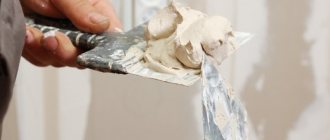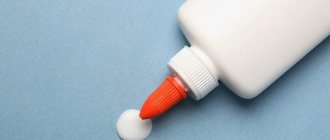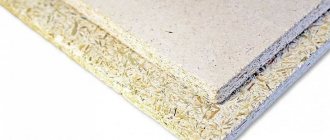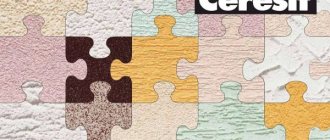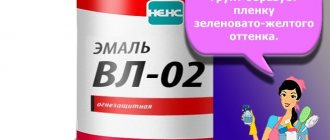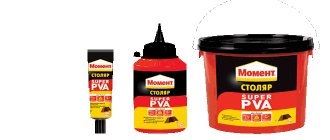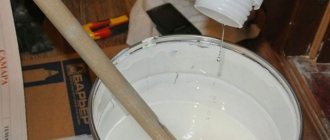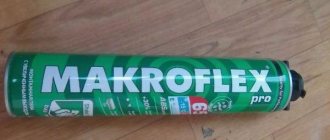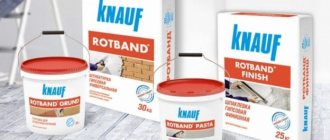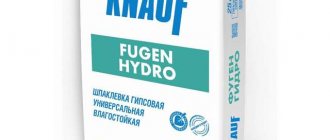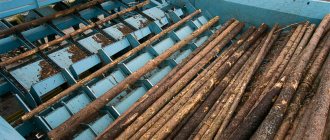Savig
6321 0 0
Savig June 13, 2017Specialization: master of interior finishing works. I am well versed in power tools for repair and construction. Formerly a teacher at a radio engineering college.
The use of adhesive putty allows you to eliminate minor defects of the treated surface and level it
Do you want to know what types and technical characteristics of adhesive putty according to GOST? I propose to look into these issues together, relying on the relevant interstate standard number 52020 2003. Photo illustrations and diagrams will help us with this.
Polymer adhesive putty
The product is universal. Suitable for ceilings, walls and floors. It is particularly elastic. Acrylic and resin are used as the base. The layer thickness varies from 4 to 5 mm.
Such compositions are available both in the form of a ready-made solution and a dry composition.
Variety No. 3: gypsum
Gypsum adhesive putty is also often called universal putty.
Although the gypsum mixture is suitable exclusively for interior work, it has a wider scope of application compared to other adhesive putties. To the above you can add:
- Freezing drywall;
- Filling wide seams;
- Leveling plastered substrates for applying paint or wallpapering.
Offer from manufacturers
Over the years, Knauf has earned a reputation as a manufacturer of high-quality and affordable products. Its prominent representative among gypsum putty mixtures can be considered “Knauf Fugen”:
| Parameter | Description |
| Brand | "Knauf" |
| Suitable materials for processing |
|
| Color | Grey |
| Weight | 25 kg |
| Maximum applied layer thickness | 3 mm |
| Minimum layer thickness | 1 mm |
| Compressive Strength | 3 MPa |
| Flexural strength | 1.5 MPa |
| Amount of water for dilution | 1.3 l per 1000 g of dry mixture |
| Price | 405 rubles |
Knauf Fugen does an excellent job of preparing walls and ceilings for painting or wallpapering
Oil-adhesive putty
Resembles a paste-like product. Accordingly, the composition contains an oily base. This type is quite common, so you can find a large number of putties with different markings on the market.
- It is worth noting that oil types are losing their popularity, because they have a strong odor.
- Often, such paint is purchased because of its low prices.
- You can use this type of finishing when renovating the premises themselves.
- Can also be used for finishing facades.
Most often, putty is applied to a previously plastered surface. Do not forget to dry the plaster well before coating.
Variety No. 2: silicate
Glue-based silicate putty can be sold either in a ready-to-use state or in the form of a powder mixture, which must first be diluted with water
Composition of silicate adhesive putty:
- Polymers;
- Fine fillers;
- Modifying Ingredients.
Advantages
The polymer component gives the material in question a number of additional positive qualities, among which the most important are:
- Excellent mechanical resistance . After hardening, polymers form a durable and reliable layer;
- High adhesion to concrete, brick and plastered surfaces. This not only simplifies the application of the solution itself, but also provides it with a long service life;
The photo shows walls leveled using silicate adhesive putty and retaining their aesthetics for many years
- Vapor permeability . Allows walls to absorb and release moisture, thereby creating an optimal microclimate for people to live in;
- Acceptable cost.
- Frost resistance . It is used not only for interior decoration, but also for exterior decoration.
Silicate adhesive putty copes well with external finishing work
Offer from manufacturers
As an example of what kind of silicate putty can be found on the shelves of construction stores, consider the DANO JET 5 mixture:
| Parameter | Description |
| Brand | SHEETROCK |
| Color | White |
| State | Dry mix |
| Weight | 25 kg |
| Approximate consumption |
|
| Maximum layer thickness | 6 mm |
| Amount of water for dilution |
|
| Curing period |
|
| Price | 440 rubles |
Here and below, prices are valid for spring 2022.
DANO JET 5 does not wash out when priming and is suitable for any mineral substrates
Features of using adhesive putty
Application of the primer can be done in 3 steps. Let's look at them in more detail:
- Preparatory step - at this stage it is necessary to clean the surface from dust, dirt and other residual materials. In addition, it is necessary to repair all the irregularities, but this is a relative task. Some professionals repair holes and pits with a thick layer of putty.
- Mixing the solution - before using the primer, you need to mix the solution, or open the jar and create a liquid emulsion. Do not forget that the instructions indicate exactly how to dilute the solution.
- Application – after the preparatory work, you can begin application. You can use a roller, brush, spray or spray gun. If you apply the solution in two layers, do not wait for the first to dry - immediately start the second.
Dilution and application of putty
Before starting work with putty, you need to study the safety requirements. The mixture is applied in a well-ventilated area, but without allowing drafts. Hands are protected with gloves during all actions, and a respirator is used when grinding. Oil compositions can catch fire, so do not work near open flame sources.
Preparing the surface for work
The preparation of the base is carried out even before opening the can of putty, since this process can take a long time. Cracks and any other defects with a depth of more than 4 mm are plastered separately, then wait for the mass to dry. Walls or other surfaces are cleaned of grease, oil, dirt, dust, and contaminants to improve the adhesion strength of the putty.
If there are peeling areas or pieces falling off, they are removed and plastered. When the wall is covered with oil paint, clean it with coarse sandpaper, then wipe off the dust with a damp cloth and allow the surface to dry. At the end of the preparatory stage, treat the base with a primer, an anti-fungal agent, and leave to dry. Ready-made commercial compounds or latex diluted with water (6:1) are used as a primer.
Required Tools
To work you will need a minimum set of tools and other equipment:
- Spatulas. Using a large spatula, apply the material to the wall and rub it, with a small spatula, take it from a jar and treat hard-to-reach places. Use a corner spatula to trim the outer and inner corners.
- Wooden stick. Used for mixing putty immediately before work.
- Sandpaper or construction float. They help in rubbing the surface after the putty has dried.
- Convenient container. If you bought putty in a large package, it is better to put it in portions in a jar or bucket. Otherwise, the bulk may dry out and become crusty.
Application of the composition
After opening the jar, the mass is mixed well. If the shelf life is coming to an end or the mixture itself seems too thick, it can be diluted with drying oil to the desired consistency. The material is applied to walls or other surfaces with a spatula (metal or rubber) in a layer of no more than 2 mm. Exceeding this figure is only possible in places where there are uneven areas.
After about 7-8 hours, begin sanding the surface with sandpaper or a grater. After a day, sanding the walls will be too difficult, because the coating will gain full strength. If it is necessary to perform a second layer of material, wait only 3-4 hours from the moment of applying the first, and begin working again.
It is only important to sand and remove dust from the coating in advance. Before performing decorative finishing, you will have to prime the walls again - otherwise oil stains may appear on them
What criteria should you use to choose?
When purchasing materials, you can make a mistake, and in the case of primers.
It is worth understanding what parameters are used to select a mixture.
The important ones are:
- Areas of use. Before purchasing, you must immediately note where the work will take place. These can be porous and smooth coatings, movable and fixed structures. Operation can take place in external or internal conditions, on different surfaces in the form of metal, plastic, polyvinyl chloride or concrete. This primer works great for this.
- Atmospheric and climatic features. In this case, temperature conditions, humidity, precipitation, the possibility of mechanical damage and much more are taken into account.
- Compositional and technical properties. Please read the instructions included with your purchase carefully.
Technical characteristics and composition
Parquet putty can eliminate uneven surfaces, deep and small defects, and also extend the service life of wood surfaces. Some craftsmen prepare the putty themselves. However, currently, building material manufacturers produce a large number of flooring solutions. They differ in the content of basic and additional components, color and operating time. However, they have similar technical parameters, which are represented by: the plasticity of the material; environmental friendliness; security; color combination with parquet flooring. There are several main options for floor putty, which differ in composition. These include the following mixtures.
Based on acrylic - they contain elastic polymers that are highly wear-resistant, durable, and environmentally friendly. Withstands mechanical loads well and increases the service life of the decorative coating. Solvent-based - the base component is wood shavings. Experts note the ease of application and rapid hardening of the solution. A significant disadvantage is the unpleasant odor, which can persist for a long time. Therefore, it is better to use this putty in conditions where sufficient ventilation can be provided. Hot melt putty - the main component is hard wax. Working with such materials requires experience and professional tools.
Therefore, this composition is rarely used. It is mainly used to treat hard-to-reach and problematic areas. Gypsum is a universal putty that has good adhesive properties. Suitable for starting and finishing work. Polymer composition - which is resistant to moisture and temperature, prevents cracks in the varnish. Suitable for floors with high performance requirements. Oil - contains natural components that saturate the wood well, allowing it to “breathe”. However, this putty takes a long time to dry and is less resistant to adverse environmental factors. Dispersed suspension - used to make putty at home. The mixture is characterized by its low price and ease of use. Used to close gaps up to 5 - 6 mm.
Consumption per 1m2
The approximate amount of putty for parquet is written in the instructions that accompany each package. The manufacturer indicates the volume of the substance based on the calculation per 1 m2 and application in one layer. However, the frequency of application may vary depending on the complexity of the work. Also, the total mass of putty is determined by the following parameters: floor area; quality of parquet; the number of layers of putty required. The amount of solution on average varies from 30 to 100 ml per square meter of coating.
Pros and cons of adhesive putty
When studying alkyd paint, it is impossible not to pay attention to a number of advantages and disadvantages of this type of paint.
pros
Among the advantages it is customary to highlight:
- Moisture resistance, wear resistance.
- Durability and light fastness properties.
- Quite low cost.
- Excellent adhesion performance for different surfaces.
- Elastic properties and crack resistance.
- Wide range of models.
- Easy application process.
- Wide choice of colors.
Minuses
The disadvantages include:
- Contents of components harmful to the human body.
- High fire hazard.
- Limited use for facade work.
You can see that the advantages of such putty outweigh its disadvantages, which makes it very popular and attractive to consumers.
The best manufacturers of adhesive putty
To correctly select high-quality adhesive-based putty, you will need to study the list of long-tested, best manufacturers of adhesive putty.
Among the most proven are:
- Hi-Gear - USA. The company's products are resistant to high temperatures. They have a high level of adhesion to materials. The composition is suitable for any base (metal and concrete). The only drawback is the unpleasant, pungent smell. Be sure to ventilate the premises during operation.
- WhiteTitan - America. It is resistant to atmospheric changes and moisture. The recommendation from experts is that you need to wear gloves and avoid getting the varnish in your eyes.
- Semin Isocol S - France. Quite a multifunctional putty. In addition, it has a high level of adhesion to materials and has grinding properties. The only drawback is that it is prohibited to use a solution that begins to harden, since its properties have already been exhausted. No material will have adhesion in this case.
- Titan Wild – Russia. It produces solutions that will be useful for your repairs at an affordable price. Can fill minor surface defects. Designed to work with plastic, plastic, plasterboard and foam. You can also use them for gluing skirting boards.
What is a PVA-based putty mixture?
Photo of the finished product.
As you know, for each type of paint you need to use a certain type of putty.
This building mixture, made on the basis of PVA, is intended for finishing surfaces made of:
- concrete;
- bricks;
- stone or;
- wood;
which in the future are planned to be painted with such coloring compounds as:
- whitewash;
- adhesive or latex paints;
- decorative oil or water-dispersed emulsions.
In other words, this material is suitable for applying almost all of the most popular decorative coloring solutions, which makes this mixture universal.
This material also has other advantages:
- environmental Safety;
- comparative speed of drying;
- long service life;
- ease of processing;
- does not crumble;
- low price;
- excellent ductility;
- good fire resistance.
In addition, an important advantage of this type of mixture is that it is not at all difficult to make with your own hands, since it does not contain any inaccessible or expensive elements. So, if it is not possible to purchase such material in finished form, then we will consider what it is made of and what parameters it should have.
Composition of PVA-based putty and its technical characteristics according to GOST
Photo of PVA construction glue.
Any instruction states that such a building material must necessarily include the following components in certain proportions (the proportions are given for applying the composition twice over an area equal to 7-8 sq. m):
- 10% adhesive solution (at least 1 l);
- chalk (about 2.5 kg);
- drying oil (25-50 g).
The manufacturing process of such material consists of the following steps:
- First, the adhesive solution is slightly warmed up.
- Then drying oil is added to it.
- After this, chalk is added with constant stirring until the desired consistency is obtained. The chalk must first be thoroughly sifted through a fine sieve.
- At the last stage, the mixture is thoroughly mixed until smooth.
The easiest way to mix the solution is to use a drill with a special attachment, as shown in the photo.
The technical characteristics of the adhesive putty according to GOST state that the PVA-based mixture must meet the following requirements:
- dry in no more than 24 hours;
- have a thick, homogeneous consistency;
- color from white to dark gray (depending on the amount of drying oil and the color of the chalk used);
- have a fine-grained structure.
